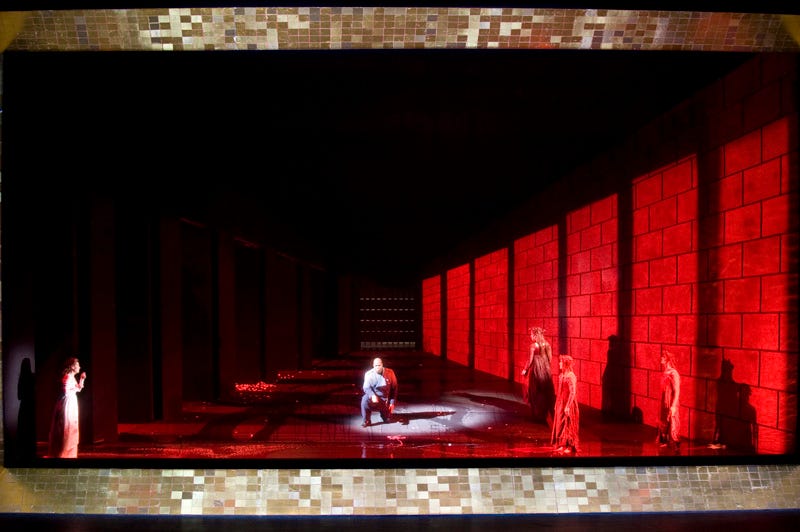It’s a fable, but it’s hard to say what the lesson is. The young Judith has left her family to marry duke Bluebeard, and as Bartòk’s opera opens, the newlyweds are arriving at his dark castle. You can leave if you want to, Bluebeard tells her. But she loves him and doesn’t want to leave. He shuts the door behind her.
Dark fables tend to hinge on a mistake; Judith’s mistake happens even before the opera begins. She agreed to marry Bluebeard and go with him to his castle, and from there, everything else is only the slow unfurling of inevitability. There are seven locked doors, which she opens one by one. Behind each door Judith discovers that everything in the castle is blood-soaked, even the jewels in the treasury, even the roses in the garden. Upon opening the final door, she finds Bluebeard’s previous wives.
They have bled to feed my garden, Bluebeard tells her. They shall live immortal.
Judith begs to be spared the fate of the others. You are the most beautiful of them all, says Bluebeard, and places a crown upon her head.
*
The music in Bluebeard’s Castle is dark but full of grandeur, with many moments of lush romantic beauty. As a teenage girl, I saw a production of it in Edmonton directed by Robert Lepage, who was known for impressive (and expensive) stage effects1. The production featured a deep pool of water at the front of the stage, and the moment when Bluebeard’s wives rose from it, dripping red, was one of the most shocking, and thrilling, experiences of my operagoing life. The emergence of the wives was paired with rhapsodic, romantic, aching music, some of the most beautiful in the opera.
The good stuff starts about 1:30 in on this track — it turns from romantic to horrifying by the end.
*
The COC’s new production is directed by Atom Egoyan, and appears to be a mashup with his serial-killer movie Felicia’s Journey. It’s available to stream here. I plan to watch, and am sorry I won’t be able to see it on stage. But the presence of a laptop in the staging rather dissuades me — for me, the best productions of this opera are the ones that take on the contours of frightening, fantastical dreams.
In the meantime, this 1980’s version for TV is dark, trippy (if perhaps a bit campy), and lushly conducted by Solti:
*
Bluebeard’s Castle pops up as a cultural reference more often than its modest popularity would suggest — and for some reason, particularly often in Canada. CanLit queen Margaret Atwood was notably obsessed by it. When I encountered it in Helen Weinzweig’s 1980 novel Basic Black with Pearls alongside various scatterings of Torontoniana (the novel also prominently features the King Edward Hotel and the portrait of the Marchesa Casati), I had to wonder if the COC had done a production sometime in the 70’s that every budding feminist writer in the city had gone to see.
Some of the one-liner interpretations that populate program notes seem hilariously off the mark. “Fundamentally, Bluebeard’s Castle is about loneliness, vulnerability, and the fear of revealing our darkest secrets to those we love,” says a program note from the Houston Symphony. Uh, really? A more common interpretation is that it’s a cautionary tale about a too-curious woman, but somehow I doubt that Judith could have been a happy bride if only she hadn’t insisted on opening those doors.
The opera seems to leave an impression on women in particular, and it’s not especially hard to see why. The dread that the handsome prince might turn out to be a monster doesn’t get much coverage in the Disney brand of fairy tales, but Judith is the dark twin of every Cinderella. Jane Eyre has hints of the Bluebeard story, and it’s telling that the story functions largely as a romance. For me, the opera is most interesting in the way it deviates from horror: It doesn’t end with screams and death, but with words of love, praise, and exaltation from Bluebeard to his bride. It makes me think of all the women who take on some version of his bargain.
He went on to create “The Machine” for the Metropolitan Opera’s Ring Cycle, by all accounts an awful piece of junk. I wish I’d seen it.




If you haven't come across Angela Carter's take in the Bloody Chamber, recommended!